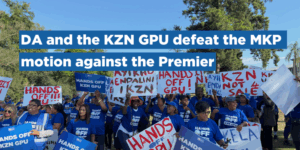The IPTN plan was adopted by Council in June 2014. This document consists of a package of medium- and long-term plans aimed at establishing a fully integrated public transport system in Cape Town by the year 2032. Apart from new MyCiTi trunk routes to be implemented, the IPTN plan also includes other modes of public transport such as new rail corridors, the need for park-and-ride facilities at rail stations, and the upgrade of existing public transport interchanges to significantly improve access and mobility within the city.
‘The implementation strategy was approved by Council yesterday, and prioritises the roll-out of five new MyCiTi corridor routes as well as the Blue Downs rail corridor within the next 15 years. This strategy underpins the City’s new Organisational Development and Transformation Plan (ODTP) which identifies dense and transit-oriented growth and development and efficient, integrated public transport as key priorities,’ said the City’s Mayoral Committee Member for Transport and Urban Development, Councillor Brett Herron.
In terms of the implementation strategy, the roll-out of the following corridors are prioritised:
- T11 MyCiTi corridor connecting Wynberg and Khayelitsha
- T12 MyCiTi corridor connecting Mitchells Plain and Claremont
- T17 MyCiTi corridor connecting Khayelitsha and Century City
- D12 MyCiTi route or Klipfontein Road corridor connecting Mitchells Plain and the Cape Town central business district (CBD)
- T13 MyCiTi route or Symphony Way corridor connecting Mitchells Plain and Durbanville
- Blue Downs rail corridor – a double-track rail link of approximately 9 km between Nolungile station in Khayelitsha and the Kuils River station with three new stations in between, namely Mfuleni, Blue Downs and Wimbledon
‘We want to have the five new MyCiTi corridors fully operational by 2032. This may sound far off, but the scale and reach of these routes is significantly bigger in comparison with the existing MyCiTi network. In fact, the five new corridors will serve at least five times the passengers that are currently traveling on the existing MyCiTi routes. It will connect some of the most disadvantaged communities to five major destinations – the Cape Town CBD, Bellville, Claremont, Wynberg and Century City.
‘As such, the roll-out of these trunk routes will accelerate our efforts to create a more equal society based on integrated communities, economic inclusion, and access to opportunities – the main pillars of the City’s ODTP,’ said Councillor Herron.
All of the City’s public transport plans revolve around and complement the Transit-Oriented Development (TOD) Strategic Framework which was adopted by Council in March 2016.
‘The TOD Strategic Framework is the City’s long-term development strategy. It prescribes how new developments across Cape Town should happen and how new and existing public infrastructure should be utilised to address the legacy of apartheid spatial planning, the high cost of public transport, and urbanisation, while also stimulating economic growth,’ said Councillor Herron.
Thus, in determining which MyCiTi routes to prioritise, the Transport and Urban Development Authority specifically considered areas where:
- the most residents would benefit from the roll-out – thus, the number of passengers to board the bus on a week day. The routes with the highest number of potential passengers were favoured
- the time passengers would save by travelling in a MyCiTi bus on a dedicated bus rapid transit route (red road), as opposed to using public transport in mixed traffic. The routes with the highest time savings were favoured
- the percentage of low-income households the routes would serve. Routes serving a higher number of lower-income households are prioritised so that the City can improve access to affordable public transport to those who need it most
- integration opportunities along a route where commuters have easy access to other modes of transport such as rail
- those currently travelling in private cars could shift to public transport such as the MyCiTi service, to travel to work and other destinations
‘In terms of the abovementioned analysis, the five MyCiTi trunk routes that we are prioritising have scored the highest. In fact, the T11 and T12 routes – Phase 2A of the MyCiTi service – showed exceptional results, confirming the urgency to roll out these routes as soon as possible,’ said Councillor Herron.
The TDA also took the capital and operational costs for each route into consideration during the prioritisation exercise, including:
- the estimated cost of the infrastructure and fleet needed for each route
- total annual operational cost for each route
- revenue/cost ratio per route
‘The ranking of the routes remained the same, even after the financial assessment of each route was completed. Thus, the roll-out of these five MyCiTi trunk routes also makes financial sense,’ said Councillor Herron.
Apart from the trunk routes, scheduled feeder services will be provided by buses in areas where there is a high demand for the MyCiTi service and where the MyCiTi stations and rail stations are not within walking distance. Unscheduled feeder services will be provided by minibus-taxis in areas where the demand is lower.
‘We also plan to provide quality bus services in other areas where the MyCiTi trunk service is not being rolled out as yet, or where the commuter demand is lower. The scheduling, fares, ticketing, efficiency and quality will be of the same standard as the MyCiTi service,’ said Councillor Herron.
The National Treasury has, through the conditional Public Transport Network Grant, allocated R1,4 billion and R1,6 billion respectively for the 2017/18 and 2018/19 financial years to the City for the provision of public transport infrastructure.
‘Given the available funding and taking into account the estimated construction costs and time it would take to complete the infrastructure for the MyCiTi trunk routes, we can only build one corridor at a time. We thus have to implement the prioritised trunk routes in sequence, starting with the T11 and T12,’ said Councillor Herron.
It will take at least 15 years to plan and construct the infrastructure needed to implement the five new MyCiTi corridors.
‘We will have to maintain and improve the existing facilities and operations while we incrementally roll out the MyCiTi trunk routes. As such, we will upgrade several public transport interchanges which are currently being used by minibus-taxis and buses, and provide new park-and-ride facilities at MyCiTi stations and rail stations,’ said Councillor Herron.
Another five MyCiTi trunk routes are planned: the T15 between Strandfontein and the Cape Town CBD; the T14 between Westlake and Bellville; the T16 between Eerste River and Blouberg; the T19 between Kraaifontein and Century City; and the T10 between Gordon’s Bay and Retreat. These routes, however, will be implemented only after 2032.




